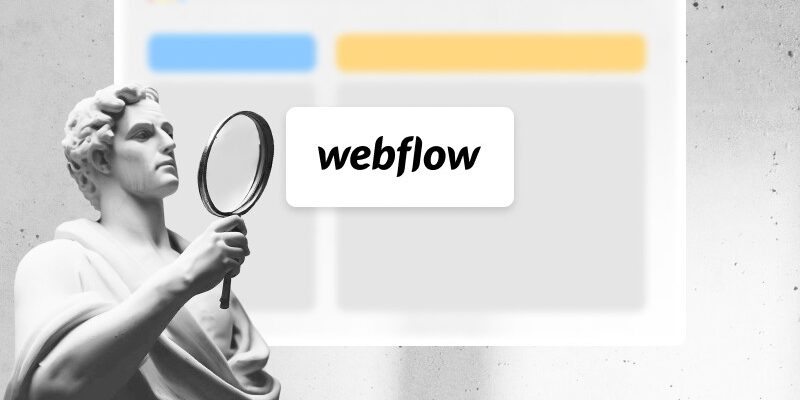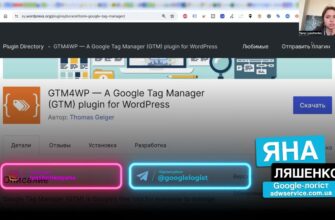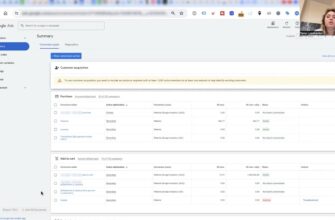- What is Webflow?
- Overview of the benefits of the Webflow platform
- Main disadvantages of the Webflow service
- Overview of Webflow website builder features
- Designer mode
- Export of designed templates
- Visual editor
- Themes
- Connecting an online store
- Dashboard
- Integrations with third-party services
- Technical support
- Opportunities to promote the site on the Webflow platform
- Blogging
- SEO optimization
- Who is the Webflow service suitable for?
- Webflow builder pricing plans
Webflow is a powerful and intuitive Landing Page builder that allows you to create not only the page structure itself, but also improve the design and work out the layout. Just as you can create graphic designs in Photoshop, this service allows you to embed those designs on a page in a convenient workspace.
Creating a project in Webflow can be compared to assembling a house from Lego. You don’t need to make the blocks yourself because they are already provided in the kit. Accordingly, you do not need to write code to create blocks on the site, since they are already pre-designed and visualized.
This time saving is a huge advantage of this service, which makes it very popular even among professional programmers. We’ve reviewed the Webflow website builder so you can evaluate its strengths and weaknesses before committing to a subscription.
How many calls and sales will I get by ordering contextual advertising from you?
I need to calculate the conversion of my website Describe
the task
in the application
Calculate potential ad revenue Google
contextual advertising calculator
What is Webflow?
Webflow is an innovative website creation platform that gives designers and developers powerful tools to bring their creative ideas to life. Founded in 2013 in sunny San Francisco, California, it quickly gained popularity among web design and development professionals due to its intuitive interface and wide range of capabilities.
Webflow is a worthy successor to traditional desktop programs used for visual layout of web pages, a prime example of which was Adobe Muse (the developers have now stopped updating it in favor of Adobe XD). However, unlike its predecessors, Webflow is more versatile, allowing you to create adaptive layouts of any complexity and purpose.
With it, you can easily create impressive business card websites, portfolios, corporate websites, resumes, promotional pages and much more. In addition, the platform provides the ability to integrate with different CMS. For example, by installing a special module, you can dynamically update content on the site using the functionality of the system.
The service is aimed at experienced designers and beginners who want to master the art of visual layout and creating high-quality web pages with a unique design. The platform is also suitable for developers creating websites for clients. However, it is worth noting that Webflow is not cheap, so you should only buy a subscription if you will actually use all the features provided.
Overview of the benefits of the Webflow platform
- Safety. All resources created on the Webflow website builder come with a free SSL certificate, which ensures encryption of data transmitted between the server and visitors, protecting confidential information from interception. Its presence increases the trust of visitors and improves the position of a web resource in search engines. At the same time, the standard cost of such a certificate is up to $100 per year (depending on the registrar).
- Fast hosting. The online builder uses hosting from Amazon Web Services (AWS), one of the leading cloud service providers in the world. It provides high download speeds and minimal downtime thanks to a distributed network of servers around the world. This guarantees stable performance even under high load.
- Ability to connect several sites on one account. This is convenient for web studios, freelancers and agencies that work with many clients. Each resource has its own separate workspace, settings and access rights, which ensures confidentiality and data security.
- Command access. The account owner can invite other users as employees and assign them roles with different access levels (designer, developer, etc.). Built-in activity tracking keeps track of who made what changes, making it easier to coordinate and control the development process.
- Designers catalog. The platform has its own directory of performers, where you can find a suitable specialist for your web project. You can filter performers by various criteria – cost of services, language of communication and competence. A web designer can create his own page in the catalog with detailed information about himself, his experience, portfolio and reviews from previous clients.
- Built-in CDN. The service uses a content delivery network (CDN) by default to ensure fast page loading. A CDN is a globally distributed network of servers that caches and sends static content (images, videos, CSS and JavaScript) to the user’s computer from a server geographically close to the user.
- Free trial period. This is a great opportunity for beginners to get acquainted with the functionality, try to create their first website and evaluate the platform. The free plan offers almost all features – design, layout, integrations and much more.
- Backup. Webflow automatically creates backups, guaranteeing data recovery in case of unforeseen circumstances. The free plan stores the last two backups, and if you need a longer history of backups, then in paid plans they are not limited either in quantity or storage time.
- Adaptive design. Built-in visual design tools allow you to create complex layouts that automatically adjust to different screen sizes. With the help of a visual designer, you can customize styles for different devices, and the result is visible in real time.
Main disadvantages of the Webflow service
- Difficult to learn for beginners. The product is aimed at professional web designers and programmers, so beginners will need time to understand the principles of operation and master all the available tools. To use it effectively, you must have basic knowledge of HTML and CSS, which can be a barrier for beginners.
- Technical limitations on hosting. Cheap plans limit the number of visitors, database items, and API requests. Therefore, with high traffic, you can easily reach the established limits, which can lead to additional costs for upgrading the tariff plan, which must be included in the project budget.
- Limitations in the free version. With the basic plan, you cannot connect your own domain, and the site will be hosted on the webflow.io subdomain, which may look unprofessional for commercial projects. There are also restrictions on the number of pages, e-commerce connection and a number of other functions.
- High cost of tariff plans. For resources with a large amount of dynamic content (blogs, portals) and online stores, tariffs can be quite expensive.
- Export features. If you want to download the created template in order to use it on another CMS, Webflow creates several files with scripts to correctly display animations, interactive elements and form processing. One of these files is significant in size – about 300 KB, which can affect download speed, especially on mobile devices or with a slow Internet connection.
- Pagination is poorly thought out. To navigate between pages, Webflow only provides Forward/Back buttons, but there is no numerical breakdown for quickly jumping to a specific page. You can display a maximum of 100 elements on one pagination page.
Overview of Webflow website builder features
If for most beginners Webflow’s capabilities may be too much, for experienced designers it will be a real godsend – you can not only create a layout for a client site, but also upload it for further use on any CMS. Next, we will give a short overview of the main functionality of the system.
Designer mode
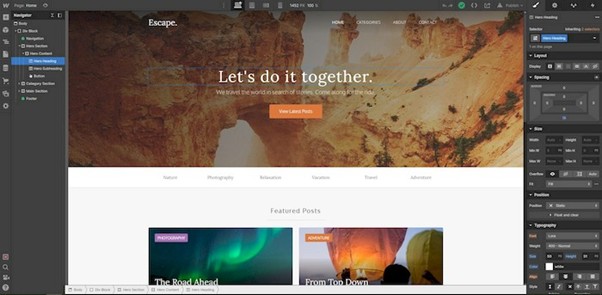
The main workspace is the designer mode, which provides access to the structure and design of web pages. In addition, the platform has a built-in editor for quickly adding content to ready-made blocks and design layouts of almost any complexity. The system uses HTML architecture and CSS style sheets to control the visual, so understanding these languages greatly simplifies the process.
The developers claim that you can work with the service without writing code manually, although there is an option to insert it. Users can select the necessary blocks from a ready-made list, combine them with each other in any order, assign styles and classes. At the same time, the designer mode is quite difficult to master for a person without training, although professionals will quickly get used to the familiar environment.
Export of designed templates
When using the paid version, users are given the opportunity to download the designed template as an archive containing HTML, CSS, JavaScript and media sources.
Webflow generates fairly clean code, without long and confusing identifiers (IDs) and date attributes. This allows you to use web pages on other CMS (for example, make up a theme for WordPress, Joomla!, etc.), without the need for significant modification.
With a competent approach to layout, you can achieve high results in performance tests – Google Page Speed and its analogues. According to reviews on the Internet, sites written in Webflow often receive 95-100 points for desktop computers and 75-90 points for mobile devices. This improves the site’s ranking in search engines and improves the usability of the project.
Visual editor
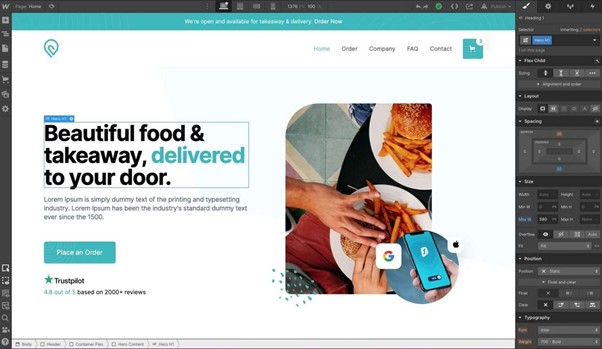
In addition to the designer mode, there is also a convenient WYSIWYG visual editor for quickly editing content, with which you can edit text blocks or manage products and categories in the online store.
The editor is convenient for making small edits to the site (after changes you can check in preview mode). However, its functions are limited: you cannot add new blocks or change the structure – for this you will still need to master the designer mode.
In addition, the visual editor is fully functional only in the desktop version, and on a smartphone you can only edit basic parameters. So this option will be useful more for the site administrator, but not for its developer.
Themes
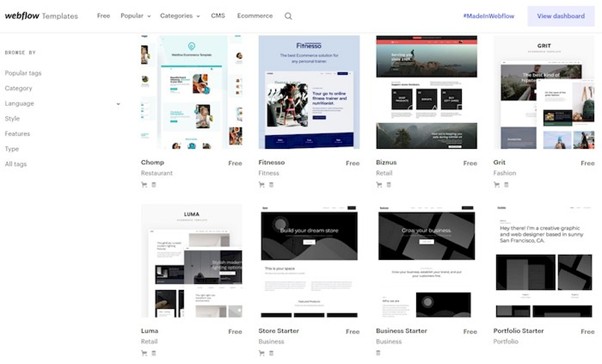
The engine is equipped with a wide selection of ready-made themes for creating attractive and professional-looking online resources. Designed by experienced web designers, they provide the perfect combination of style, functionality and thoughtful usability.
All templates are well-designed and include a set of consistent styles, color palettes, typography and interface elements. This helps to create a holistic and harmonious visual without wasting extra time. Any ready-made theme can be modified by changing colors, fields in feedback forms, block sizes and styles, and much more.
Most themes are paid and cost $25 to $150, and their quality remains consistently high. The collection includes templates for business cards, portfolios, online stores, landing pages, promo pages and blogs. About 40 templates are available for free, and the quality is comparable to paid versions.
Connecting an online store
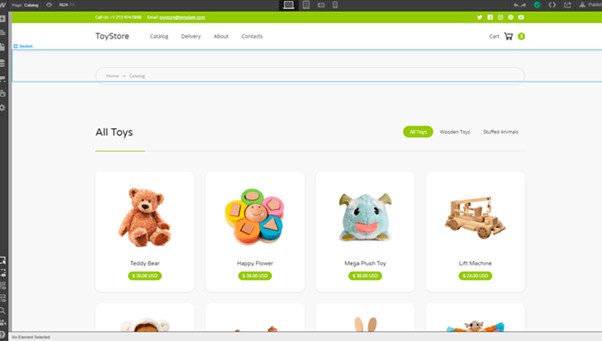
You can add online store functionality with one click using a special module in the side menu. After enabling the module, all you have to do is add your products and customize the design to suit the desired appearance of the store – use a ready-made template or create a custom one.
The number of products that can be placed depends on the limit provided by your tariff plan. A similar restriction applies to blog articles. Therefore, the service is not suitable for large online stores. At the same time, convenient import/export of product data in XML format is provided, using a ready-made template.
You can also add products manually by filling out the main fields – the main image and additional photos, specify the price including discounts and taxes, select the currency, category, delivery methods and characteristics. The set of fields for product cards is fully customizable – you can remove unnecessary ones or add additional parameters.
How many calls and sales will I get by ordering contextual advertising from you?
I need to calculate the conversion of my website Describe
the task
in the application
Calculate potential ad revenue Google
contextual advertising calculator
After launching an online store in the admin panel, templates for displaying the catalog, categories, cart and other necessary sections will automatically appear in the Webflow pages section. They can be edited in designer mode, like any other project layouts.
For eCommerce projects based on Webflow, you can also:
- Sell both physical and digital goods;
- Add custom fields for categories and individual products;
- Create your own promotional selections of products, attaching a discount or free shipping to them;
- Accept payments online – for this, Stripe and PayPal are integrated into the engine;
- Use API or Zapier to integrate third-party services without programming skills;
- Track active and completed orders in the editor panel (a stripped-down analogue of a CRM system);
- Create your own landing pages for specific product items;
- Send automatic notifications to clients using custom templates (for this you can connect a third-party e-mail distribution system or use the built-in one);
- Import themes from ThemeForest;
- Use templates to automatically generate Title and Description for pages (SEO specialists will appreciate this feature);
- Send users personalized offers and discount coupons.
Dashboard
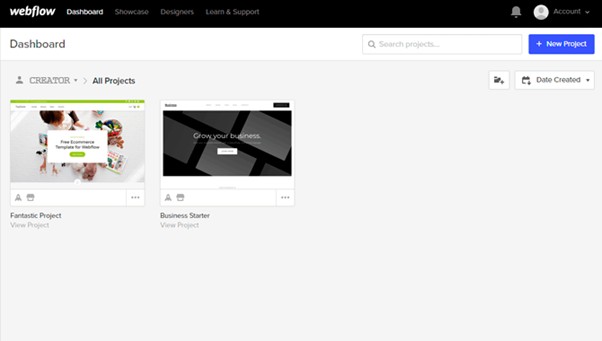
Dashboard is a fully functional personal account, a management center for all projects. Here you can create and edit connected sites, configure favicons for them, connect statistics collection services, set up SEO optimization for pages, and much more. Projects can be divided into folders and, if necessary, they can be duplicated or imported from other sources.
The dashboard also provides access to a connected community of users. Here you can view the portfolios of other web designers and developers and subscribe to authors whose designs you like. You can also publish your best works for self-presentation (thus, a talented layout designer can receive orders for his services).
For an easy search for an artist, personal account statistics are displayed here – the number of subscribers, likes and published web projects. Using this data, you can increase your rating in the community and build a promotion strategy as a specialist. Or look for a contractor for your tasks.
Here you can also find a section with reference information, which contains an extensive knowledge base – articles, video tutorials and answers to frequently asked questions. All information is presented in English, which can be a problem for users who do not speak English.
Integrations with third-party services
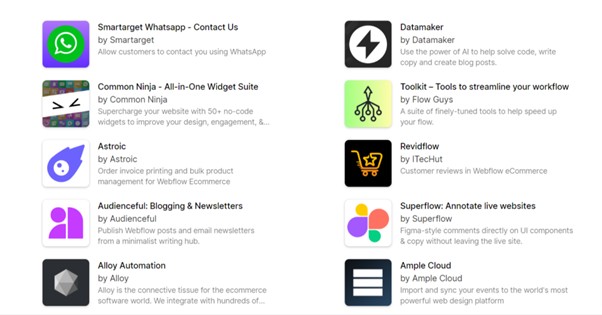
Sometimes the built-in functionality may not be enough to implement all business tasks. In such cases, you have to resort to integrating external services, since Webflow does not have its own extension catalog. Most integrations are done by pasting code or using the API.
To simplify the process of integrating third-party services, you can use online automation platforms that connect various applications and services without the involvement of web developers.
For example, you can use Zapier to automatically process data received through a web form. When receiving information about a new order, Zapier can send this data via email, SMS or Telegram chat, as well as perform many other actions depending on the configured scenario.
Technical support
Judging by user reviews, in terms of technical support, the company does not always live up to expectations. The only way to contact a specialist is by email, even for high-end subscribers.
According to reviews on the Internet, receiving a response from a company representative can take up to 48 hours, which is a very long time. During this time, a solution to the problem is usually found independently, and the support response is no longer relevant.
Despite these defects in customer service, the system of the system presents an extensive library of courses and training video materials. They help to master the work with the engine independently, which partially compensates for the shortcomings of the support service.
Opportunities to promote the site on the Webflow platform
Given the importance of attracting traffic and improving visibility in search engines, the Webflow platform provides all the necessary tools and functions that help solve these problems.
Blogging

On Webflow, you can both create a blog from scratch and add the appropriate section to a ready-made one-page or online store. The functioning of the blog is based on CMS Collections – a set of pages templates for different tasks.
In standard collections, a set of certain fields for each recording is determined – text, title, images, date of publication and any others. They can be filled with the necessary content, from which the blog entries are formed. Ready-made output templates are provided for publishing recipes, companies catalog or instructions such as DIY.
You can also set the rules for the output of posts, specify the password for a closed blog, configure SEO, RSS and page parameters in social networks. When the base of posts is ready, the blog is automatically generated with a tape of recordings in a chronological order. The visual solution can be completely configured independently or use ready-made presets.
The main restriction – the number of records is limited, depending on the tariff plan. But for most tasks, this is more than enough, so the service is perfect for both the personal blog and for commercial.
SEO optimization
The sites from the box created on Webflow are designed taking into account the requirements of search engines: the layout opens equally well on all devices, an additional plus in ranking gives a clean HTML code and high loading speed.
But besides this, the platform also makes it possible to configure meta-tags, headlines, edit Robots.txt, and Sitemap.xml generation is automatically based on the base of all created pages. For the correct display of the site in social networks and instant messengers, the marking of Open Graph.
Also for large sites, the Title and Description automatic generation is provided using variables. And to connect the collection of statistics and the analyst Google Analytics and Facebook Pixel can be literally in one click.
Who is the Webflow service suitable for?
Webflow’s sites designer is designed mainly for professional web designers and web studios. It allows them to create web projects faster and cheaper at the expense of a number of advantages:
- You do not need to separately develop layouts in Figma or Adobe Photoshop, and then transfer them using a layoutor. The whole process occurs in one interface-from the prototype to the finished resource, which accelerates the work 2-3 times.
- The system itself converts the created design into pure HTML and JavaScript, ready for publication. At the same time, the professional level of code is not inferior to a manual mile.
- CMS allows you to organize an effective workflow in a team of designers and developers over one online project in real time. For this, there are tools for monitoring versions, amendments and commenting of actions.
- For full service of the site, a team of developers do not need. Everything necessary has already been implemented. Therefore, even one designer will be able to work with the platform independently, without involving the front end programmers
- You can easily export the created site and use it to any CMS. It will be useful for both its projects and when customer-order development.
Webflow builder pricing plans
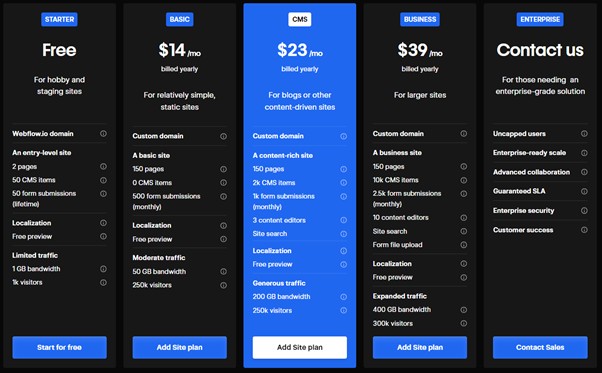
Webflow designer offers 4 main tariffs:
- Free. On these projects you can create an unlimited number of web projects, but with a limitation of 2 pages and 50 positions on a temporary domain type NAME.WebFlow.io. Therefore, this option is well suited only for familiarization with the functionality.
- Basic. The plan for $ 14 per month allows you to publish web resources on its own domains with basic functions and provides for a limit of 150 pages and 250 thousand visitors. The tariff is suitable for placing simple single-page visits sites or small promo sites, but not suitable for medium and large businesses.
- CMS. The tariff with a monthly fee of $23 offers the placement of online projects on an unlimited number of own domains with full functionality, but with a limit of 150 pages and 2000 goods. Here you can already create full-fledged stores. True, the number of commodity positions is still limited.
- Business. The tariff plan for $39 is intended for web studios and agencies. Here you can unload the designs developed by yourself for use on other engines, connect up to 10 administrator accounts, and 300,000 users per month. traffic.

